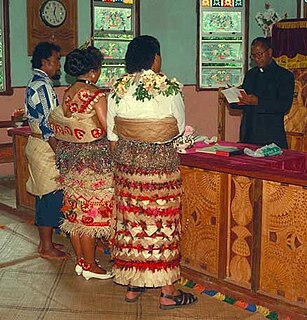 W
WAn ʻie tōga is a special finely woven mat that is an important item of cultural value in Samoa. They are commonly referred to in English as "fine mats" although they are never used as 'mats' as they only have a purely cultural value. ʻIe tōga are valued by the quality of the weave and the softness and shine of the material. They are made by women and form an important part of their role, identity and skill in their community.
 W
WFeather cloaks have been used by several cultures.
 W
WNew Zealand flax describes the common New Zealand perennial plants Phormium tenax and Phormium colensoi, known by the Māori names harakeke and wharariki respectively. Although given the common name 'flax' they are quite distinct from the Northern Hemisphere plant known as flax
 W
WKapa is a fabric made by native Hawaiians from the bast fibres of certain species of trees and shrubs in the orders Rosales and Malvales.
 W
WA kiekie is a Tongan dress, an ornamental girdle around the waist, mainly worn by women on semiformal occasions, but nowadays also sometimes by men. At highly formal occasions both gender will settle for a taʻovala. At casual occasions no girdle is needed for any gender, although women may continue wearing a kiekie even then, as it is considered an easy sitting, nice looking decoration, with which one can show off..
 W
WA lavalava, also known as an 'ie, short for 'ie lavalava, is an article of daily clothing traditionally worn by Polynesians and other Oceanic peoples. It consists of a single rectangular cloth worn similarly to a wraparound skirt or kilt. The term lavalava is both singular and plural in the Samoan language.
 W
WLei is a garland or wreath. More loosely defined, a lei is any series of objects strung together with the intent to be worn. The most popular concept of a lei in Hawaiian culture is a wreath of flowers presented upon arriving or leaving as a symbol of affection. This concept was popularized through tourism between the Hawaiian Islands and the continental United States in the 19th and 20th centuries.
 W
WLīloa's Kāʻei (Liloa's Sash) or Kāʻei Kapu o Liloa (the sacred sash of Līloa) is the sacred feathered sash of Līloa, king of the Big Island of Hawaiʻi. The Statue of Kamehameha the Great, commissioned by King Kalākaua, displayed the kāʻei.
 W
WMāori traditional textiles are the indigenous textiles of the Māori people of New Zealand. The organisation Te Roopu Raranga Whatu o Aotearoa, the national Māori weavers' collective, aims to preserve and foster the skills of making and using these materials.
 W
WA Mother Hubbard dress is a long, wide, loose-fitting gown with long sleeves and a high neck. It is intended to cover as much skin as possible. It was devised in Victorian western societies to free women from the constriction of corsets that fashion imposed on wealthier women. It is mostly known today for its later introduction by Christian missionaries in Polynesia to "civilise" those whom they considered half-naked savages.
 W
WThe muumuu or muʻumuʻu is a loose dress of Hawaiian origin that hangs from the shoulder and is like a cross between a shirt and a robe. Like the aloha shirt, muumuu exports are often brilliantly colored with floral patterns of generic Polynesian motifs. Muumuus for local Hawaiian residents are more subdued in tone. Muumuus are no longer as widely worn at work as the aloha shirt, but continue to be the preferred formal dress for weddings and festivals such as the Merrie Monarch hula competition. Muumuus are also popular as maternity wear because they do not restrict the waist.
 W
WNāhiʻenaʻena's Pāʻū is the largest known Hawaiian feather cloak. It is a feather skirt (pāʻū) made for Princess Nāhiʻenaʻena.
 W
WThe pāreu or pareo is the Cook Islands and Tahitian word for a wraparound skirt. Originally it was used only to refer to women's skirts, as men wore a loincloth, called a maro. Nowadays the term is applied to any piece of cloth worn wrapped around the body, worn by males or females. It is related to the Malay sarong, Filipino malong, tapis and patadyong, Samoan lavalava, Tongan tupenu and other such garments of the Pacific Islands such as the Hawaiian Islands, Marquesas Islands, New Zealand, Fiji and Tremiti island
 W
WPossum-skin cloaks were a form of clothing worn by Aboriginal people in the south-east of Australia – present-day Victoria and New South Wales.
 W
WA sarong or sarung ; is a large tube or length of fabric, often wrapped around the waist, worn in Southeast Asia, Southern Asia, Western Asia, Northern Africa, East Africa, and on many Pacific islands. The fabric often has woven plaid or checkered patterns, or may be brightly colored by means of batik or ikat dyeing. Many modern sarongs have printed designs, often depicting animals or plants. Different types of sarongs are worn in different places in the world, notably, the lungi in the Indian subcontinent and the izaar in the Arabian Peninsula.
 W
WA taʻovala is an article of Tongan dress, a mat wrapped around the waist, worn by men and women, at all formal occasions, much like the tie for men in the European and North American culture. The ta'ovala is also commonly seen among the Fijian Lau Islands, a region once heavily influenced by Tongan hegemony and cultural diffusion.
 W
WTapa cloth is a barkcloth made in the islands of the Pacific Ocean, primarily in Tonga, Samoa and Fiji, but as far afield as Niue, Cook Islands, Futuna, Solomon Islands, Java, New Zealand, Vanuatu, Papua New Guinea and Hawaii. In French Polynesia it has nearly disappeared, except for some villages in the Marquesas.
 W
WTupenu is the Tongan term for a wrapped garment also called a sarong, lungi, or lava-lava, worn through much of South Asia, Southeast Asia, Arabian peninsula, the Horn of Africa and Oceania. It is analogous to the kilt worn in Scotland.